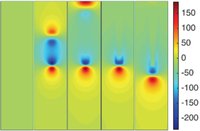In the search for better performing and environmentally friendly high-voltage switches, it is important to understand electrical breakdowns in various media. PhD student Ashutosh Agnihotri from Centrum Wiskunde & Informatica (CWI) developed and applied efficient computational models to simulate these phenomena in different gas mixtures. He defends his PhD thesis ‘Modeling heat dominated electrical breakdown’ at Eindhoven University of Technology on 25 June 2018. The results are relevant for high voltage technology and can be used in the context of atmospheric lightning.
Successful transition to renewable energy sources such as sun and wind requires efficient transmission of electrical energy. This can be done in a high-voltage electricity grid. To control the electric current in this grid, electrical switches and circuit breakers are used. Until now, mostly sulphur-hexa fluoride (SF6) has been used in switches for its excellent interruption properties. However, it is also an extremely strong greenhouse gas with toxic by-products. This creates a need for investigating new gas mixtures that are more environmentally friendly. Consequently, researchers want to investigate electrical breakdown phenomena - such as sparks - in these new media through experiments and computer simulations.
However, simulating a spark is computationally challenging due to the multitude of length and timescales involved in the physics of the problem. To tackle this, Agnihotri developed new methods to improve the performance speed of the simulations. He used his new models to study how a spark develops in atmospheric air and high-pressure nitrogen. In the future, the new models can be integrated in the tool suite available for electric breakdown phenomena.
Agnihotri performed his research as a PhD candidate in the CWI Multiscale Dynamics group, headed by Prof. Ute Ebert. Principal investigators were Prof. Willem Hundsdorfer and Prof. Ebert. Willem Hundsdorfer sadly passed away in 2017. The research was funded under the Industrial Partnership Programme (IPP) Computational Sciences for Energy Research the Foundation for Fundamental Research on Matter (FOM), which is part of the Netherlands Organisation for Scientific Research (NWO). The CSER initiative is co-financed by Shell Global Solutions International B.V.

Picture: Simulation by Ashutosh Agnihotri.
More information
